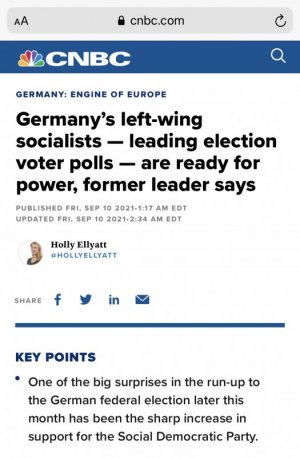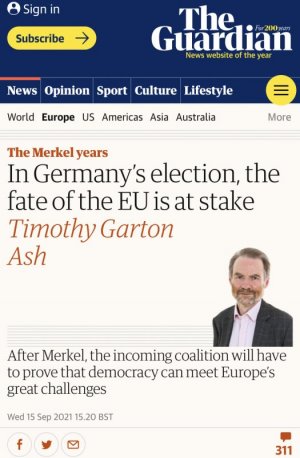So, later this month there’s a federal election in Germany, alongside simultaneous state elections in Berlin and Mecklenburg-Vorpommern.
So, who are the contenders? (Remember that German governments are multi-party coalitions, with rare exceptions.)
CDU/CSU – the dominant centre-right bloc formed by Christian Democratic Union, and its much more conservative Bavarian counterpart the Christian-Social Union. Led by (relatively centrist, by CDU standards) outgoing Chancellor Angela Merkel, who’s retiring from politics. Has governed Germany since 2005, either in coalition with the SPD (as currently) or FDP. The CDU governs seven German states as either the major or minor coalition partner, while the CSU has continuously governed Bavaria during the postwar period. The CDU/CSU chancellor candidate is Armin Laschet, Minister-president of Nordrhein-Westfalen, who has been affected in recent polling by his personal unpopularity. Parties colour: black (unofficially, but ubiquitous).
SPD – Germany’s main centre-left party and alternative party of government, formed in the European social-democratic tradition. Currently junior partner to the CDU/CSU in federal government, CDU in three states, Linke in Thuringia, and leading party in seven states (with Grüne, FDP, CDU and Linke all junior partners to various SPD Minister-presidents). Chancellor candidate Olaf Scholz is generally popular, and is currently the Vice Chancellor of Germany. German President Frank-Walter Steinmeier is also a SPD member. Party colour: red.
Grüne – the Greens, an ecologically-aware centre-left party. Socially progressive, economically increasingly moderate. Stronger in the West, urban areas and among university graduates. Temporary polled higher than the SPD or even the CDU/CSU earlier this year, but declined due to the unexpected revival of the SPD and the struggles of chancellor candidate Annalena Baerbock. Preferred coalition partner of the SPD, whom they govern with in several states, and in federal government 1998–2005. However, the Greens are also happy to govern with the CDU – Baden-Württemberg is currently governed by a Green Minister-president with CDU as minor partners, while Saschen-Anhalt and Brandenburg have SPD/CDU/Grüne (“Kenya”) coalition governments. Party colour: green, obv.
FDP – Germany’s traditional postwar third party; a “liberal” party, but not in the sense commonly known in North America or Britain. To the right of the CDU/CSU on economics, a big-business neoliberal party, but all over the place on social issues. Often has a stink of libertarian edgelord about it. Currently questioning the legitimacy of pandemic lockdowns. Prefers coalitions with the CDU/CSU, as currently in Nord Rhine-Westphalia and Schleswig-Holstein, but is also currently in a “traffic-light” coalition with SPD and Grünen in Rhineland-Pflaz. (Also notoriously had a Minister-president of Thuringia for a day or two last February with the ‘help’ of the AfD.) Party colour: yellow.
AfD – a ‘populist’ far-right party, borderline if not actually neofascist in places. Unlike the traditional blood-and-soil parties of its type, generally neoliberal rather than state-interventionist in economics, being to the right of FDP on some issues. Stronger in the former East Germany. None of the mainstream parties will form a coalition with the AfD, so has no realistic chance of entering government. Currently exploiting anti-lockdown and anti-vaxx feelings. Party colour: blue (official), brown (some media).
Die Linke – an overtly socialist party, legal successor to the SED, the East German communist party. Stronger in the East. Pro-Russia and europhobic in foreign policy, populist and rather nativist, making it somewhat similar to AfD in places. Would like a “red-red green coalition” with the SPD and Greens, but those parties would be reluctant to form a federal government with Die Linke (despite governing that way in Bremen and Thuringia, the latter with a Linke Minister-president). Party colour: red (official), dark red or purple (media).
Freie Wähler – “Free Voters”, a small conservative party made up of associations at state level. Unlikely to enter the Federal Parliament, but could surprise us. Currently junior partner to the CSU in the government of Bavaria. Party colour: orange.
So, who are the contenders? (Remember that German governments are multi-party coalitions, with rare exceptions.)
CDU/CSU – the dominant centre-right bloc formed by Christian Democratic Union, and its much more conservative Bavarian counterpart the Christian-Social Union. Led by (relatively centrist, by CDU standards) outgoing Chancellor Angela Merkel, who’s retiring from politics. Has governed Germany since 2005, either in coalition with the SPD (as currently) or FDP. The CDU governs seven German states as either the major or minor coalition partner, while the CSU has continuously governed Bavaria during the postwar period. The CDU/CSU chancellor candidate is Armin Laschet, Minister-president of Nordrhein-Westfalen, who has been affected in recent polling by his personal unpopularity. Parties colour: black (unofficially, but ubiquitous).
SPD – Germany’s main centre-left party and alternative party of government, formed in the European social-democratic tradition. Currently junior partner to the CDU/CSU in federal government, CDU in three states, Linke in Thuringia, and leading party in seven states (with Grüne, FDP, CDU and Linke all junior partners to various SPD Minister-presidents). Chancellor candidate Olaf Scholz is generally popular, and is currently the Vice Chancellor of Germany. German President Frank-Walter Steinmeier is also a SPD member. Party colour: red.
Grüne – the Greens, an ecologically-aware centre-left party. Socially progressive, economically increasingly moderate. Stronger in the West, urban areas and among university graduates. Temporary polled higher than the SPD or even the CDU/CSU earlier this year, but declined due to the unexpected revival of the SPD and the struggles of chancellor candidate Annalena Baerbock. Preferred coalition partner of the SPD, whom they govern with in several states, and in federal government 1998–2005. However, the Greens are also happy to govern with the CDU – Baden-Württemberg is currently governed by a Green Minister-president with CDU as minor partners, while Saschen-Anhalt and Brandenburg have SPD/CDU/Grüne (“Kenya”) coalition governments. Party colour: green, obv.
FDP – Germany’s traditional postwar third party; a “liberal” party, but not in the sense commonly known in North America or Britain. To the right of the CDU/CSU on economics, a big-business neoliberal party, but all over the place on social issues. Often has a stink of libertarian edgelord about it. Currently questioning the legitimacy of pandemic lockdowns. Prefers coalitions with the CDU/CSU, as currently in Nord Rhine-Westphalia and Schleswig-Holstein, but is also currently in a “traffic-light” coalition with SPD and Grünen in Rhineland-Pflaz. (Also notoriously had a Minister-president of Thuringia for a day or two last February with the ‘help’ of the AfD.) Party colour: yellow.
AfD – a ‘populist’ far-right party, borderline if not actually neofascist in places. Unlike the traditional blood-and-soil parties of its type, generally neoliberal rather than state-interventionist in economics, being to the right of FDP on some issues. Stronger in the former East Germany. None of the mainstream parties will form a coalition with the AfD, so has no realistic chance of entering government. Currently exploiting anti-lockdown and anti-vaxx feelings. Party colour: blue (official), brown (some media).
Die Linke – an overtly socialist party, legal successor to the SED, the East German communist party. Stronger in the East. Pro-Russia and europhobic in foreign policy, populist and rather nativist, making it somewhat similar to AfD in places. Would like a “red-red green coalition” with the SPD and Greens, but those parties would be reluctant to form a federal government with Die Linke (despite governing that way in Bremen and Thuringia, the latter with a Linke Minister-president). Party colour: red (official), dark red or purple (media).
Freie Wähler – “Free Voters”, a small conservative party made up of associations at state level. Unlikely to enter the Federal Parliament, but could surprise us. Currently junior partner to the CSU in the government of Bavaria. Party colour: orange.


